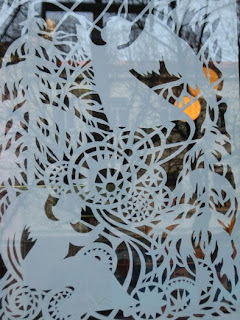Friday 30 October 2009
Movie
http://www.youtube.com/watch?v=cwoLp-rATS8&feature=related
Wednesday 28 October 2009
Tuesday 27 October 2009
Monday 26 October 2009
Blinking in the daylight
Sunday 25 October 2009
nothing but blue skies



But that was my only taste of daylight for the last few days as we got round to hanging the work in the trophy room at the museum. All the crates had arrived safely from Dublin. The first job was to get the ceiling lights colour wrapped and then to start laying out the trees across the ceiling grid. Here you can see Lukas on tree no 12....
Monday 19 October 2009
Diorama Dramas


In a way, this is what we are doing with our piece - putting the animals into context.
I have been looking at birch trees a lot recently, working on the burning and markmaking. In his Flora Britannica, Richard maybe dscribes them as a pioneering species - I like the term.

Sunday 18 October 2009
Fun with a soldering iron

And then getting down to the solid work of churning out 66 of these trees. This took almost two weeks and about 100 burns from the soldering iron

One of the trees held up under a tungsten light source in the studio to give an idea of the effect:
 It was then my job to take these papers out to Emcon in Dublin and load them up into the perspex rods that would protect them and give them form. A photo here before the fiddly job of getting them in the tubes:
It was then my job to take these papers out to Emcon in Dublin and load them up into the perspex rods that would protect them and give them form. A photo here before the fiddly job of getting them in the tubes: Here is one I prepared earlier:
Here is one I prepared earlier: Here are some more I prepared in their little protective sleeves. It was at about tube no 30 I begin to realise the scale of the task ahead.
Here are some more I prepared in their little protective sleeves. It was at about tube no 30 I begin to realise the scale of the task ahead.
 A view down inside one of the trees:
A view down inside one of the trees:
Once this job was done we fired up the LEDs in the tubes to test for any failures and to burn them in for a few days to catch any early board failures. Whilst I had been filling the tubes, the lads at Emcon had been building the control system and wiring and soldering all the LEDs and really pulling out all the stops to make this piece as easy to assemble at the other end as possible.

The guys at Emcon were able to hang them from the their cable supports and we could start putting some of the moving light programming through the system and getting a sense of what it was going to look like:
 I then came to London last week and Peter Barry had rigged up a remote webcam and web link to the programming computer to allow me remote access to program the lighting effects at my leisure:
I then came to London last week and Peter Barry had rigged up a remote webcam and web link to the programming computer to allow me remote access to program the lighting effects at my leisure:

Tuesday 13 October 2009
66 trees in the forest
She had also been looking at the traditional paper cut winter decorations that you can see all over Lithuania on the run up to Christmas. They are called Karpiniai and are put up in the windows to cast beautiful shadows and silhouettes. Here is one from the windows of the primary school that is opposite the museum:



The lighting would transmit up a tube like this for over a metre. These 'trees' could then be hung in the trophy room from the ceiling, each sealed into a perspex tube like the taxidermy exhibits themselves behind their glass cases. We put a visual together to give an ideas of what this would look like:




.jpg)













+-+for+exhibition+at+biennale.jpg)
+-+for+exhibition+at+biennale.jpg)
